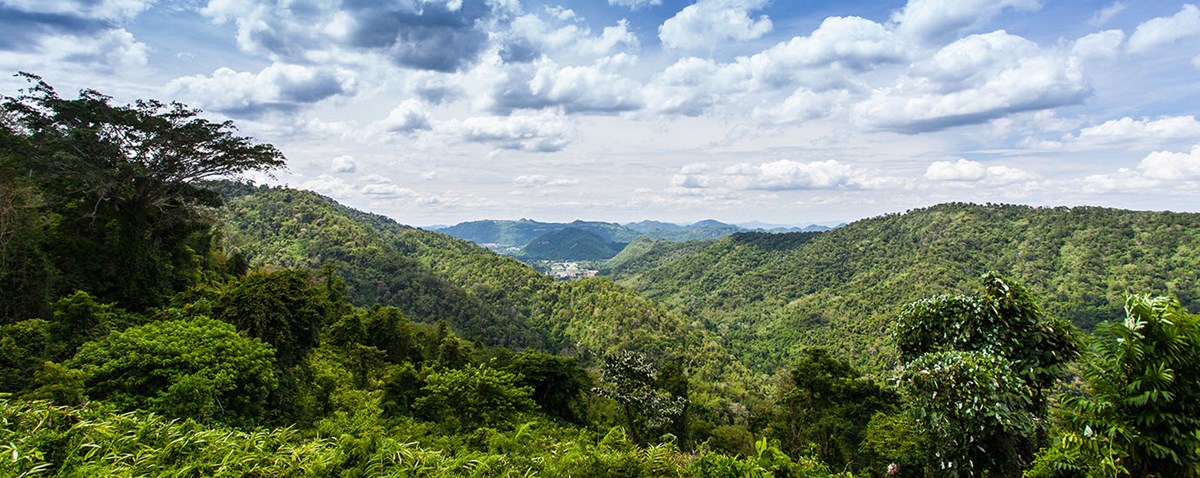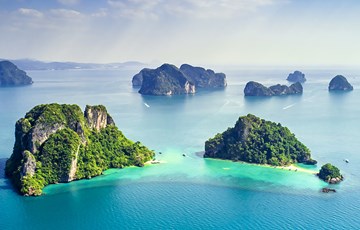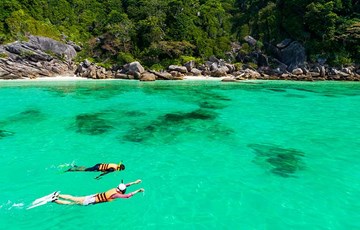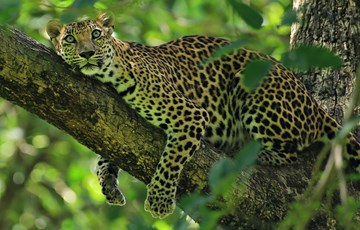
5 alternative places in Thailand that will benefit from your post-lockdown visit
The shimmering shores of Phuket and Koh Samui may entice the lion’s share of Thailand’s sun-seekers, but away from the hordes are little-visited secrets hiding wildlife, rugged landscapes and even a floating art market. Here are 5 peaceful places for a post-lockdown visit…
1. Contrast Bangkok with Chiang Mai


A rice field in Chiang Mai (Tourism Authority of Thailand)
Chiang Mai, with its elegant architecture, thriving creative community and surrounding natural beauty, is a more laidback alternative to bustling Bangkok. This northern city is rich in both culture and nature, with a wealth of boutique hotels and authentic eateries to choose from. The cooler climate and compact size makes it easier to explore than the capital, and you can wander the frangipani-shaded boulevards or go further afield by bike.
 Grab coffee at the much-acclaimed Akha Ama café that only sells sustainably-grown beans harvested by the Akha hill tribe or lunch at Rustic and Blue, a folksy farm-to-table canteen that serves artisan fare and sometimes hosts pop-up feasts on farms and fields where its produce is grown. When night falls, have a sundowner at the bar-gallery Thapae East that hosts art shows in its atmospheric courtyard. Hit the city’s famous carnival-like Sunday Market and riverside Night Bazaar for handicrafts, homeware, street food and live music. In the heart of the old city, the Vocational Training Centre of the Chiang Mai Women’s Correctional Institute offers fantastic massages by female inmates participating in the prison’s job-training scheme. Its lovely courtyard café is a great spot for a post-massage lunch.
Grab coffee at the much-acclaimed Akha Ama café that only sells sustainably-grown beans harvested by the Akha hill tribe or lunch at Rustic and Blue, a folksy farm-to-table canteen that serves artisan fare and sometimes hosts pop-up feasts on farms and fields where its produce is grown. When night falls, have a sundowner at the bar-gallery Thapae East that hosts art shows in its atmospheric courtyard. Hit the city’s famous carnival-like Sunday Market and riverside Night Bazaar for handicrafts, homeware, street food and live music. In the heart of the old city, the Vocational Training Centre of the Chiang Mai Women’s Correctional Institute offers fantastic massages by female inmates participating in the prison’s job-training scheme. Its lovely courtyard café is a great spot for a post-massage lunch.


See elephants ethically at Chiang Mai's Elephant Nature Park (Shutterstock)
Surrounded by mountains, valleys and forests, there’s an abundance of adventurous ways to explore Chiang Mai’s verdant backdrop and day-trip excursions offer everything from white-water rafting to meeting hill-tribes and of course encounters with elephants. Be sure to pick an ethical sanctuary such as the Elephant Nature Park and Happy Elephant Home in the nearby mountainside. Also make sure you consider the responsibility of your tour company: Green Trails, for example, has great eco-credentials and will take you on rafting expeditions, rainforest hikes and coffee tours, all while giving back to the local community.
2. Add Krabi to Phuket

One of Krabi's pristine beaches (Tourism Authority of Thailand)
Phuket on the west coast of Thailand is the country’s biggest and busiest island, but nearby Krabi is Phuket’s less-crowded sibling. Famous for its craggy, sheer limestone cliffs jutting out of the ocean, it’s one of those places where nature simply takes your breath away. Krabi’s appeal lies in its ability to please thrill seekers and nature lovers alike. The jungle-draped island is ripe with activities: you can snorkel, dive, hike or just have a quiet dinner by the shore.
The Rayavadee eco-retreat bordering Krabi Marine National Park is dedicated to rejuvenating threatened marine life, tropical birds and jungle creatures. Tucked amid coconut groves against a backdrop of cliffs, it’s an amazing place to stay and dining at the Grotto - its sea-facing restaurant in a cave - is worth the visit alone.

Explore Krabi's Mangroves by kayak (Shutterstock)
Krabi’s many attractions include the Ao Luk mangroves, the Khlong Thom hot springs and the Tiger Cave Temple, which sits atop more than 1,000 stairs. The string of islands floating off its shore makes it a great hub for island-hopping, too.
Wander Krabi’s charming town to find open-air restaurants, quaint cafes and floating markets. From there you can catch a longtail through the mangroves to Railay Beach. Hemmed in by the dramatic bluffs and bushy rainforest, Railay offers a pristine stretch of sand. Snorkel in its crystalline waters, explore its secret coves or brave a jump into the water from the cliffs. On West Railay Beach, there’s promenade with a handful of shops and cafes, along with many longtails moored on its shore that can take you to the outlying islands.
3. Try Koh Lipe, the 'new' Koh Samui

Koh Lipe's crystal clear waters (Shutterstock)
Koh Samui has its many charms with no shortage of sleek resorts, barefoot luxury and tropical vistas. But those seeking something slower-paced and low-key should opt for Koh Lipe. This colourful sliver of castaway paradise on the Malaysian border offers wild jungle-covered hills, coconut-lined beaches and a lively evening street food scene. Far from the crowded hotspots, Koh Lipe is a quiet, intimate escape smack in the middle of Tarutao National Marine Park, with no cars and only a few motorcycle taxis. The silver-green waters off this little romantic island are so clear you can see fish swimming in the shallows and its nearby reefs are teeming with aquatic life, including sea turtles, black urchins and the adorable dugongs, often referred to as sea cows and relatives of the manatee.

Koh Lipe offers incredible snorkelling (Shutterstock)
Originally only inhabited by Sea Gypsies (the Chao Ley) who still live in the ancient stilted fishing villages, the L-shaped island has three beaches. Pattaya Beach is the main stretch of sand, while Sunrise and Sunset beaches are known for their burning red skies. Sheltered by giant granite boulders, Sunset Beach is unspoilt and deserted, but is the place to be just before nightfall, where the setting sun shimmers orange on the water and lights up the horizon. The beaches are connected by Walking Street, a stretch of family-owned fresh-fruit smoothie shacks and quirky cafes, bars and shops. Several lodging choices are available, from bamboo-and-thatch cottages to luxe seaside villas.
4. If you like Koh Lanta, try Koh Libong


One of Koh Libong's fishing villages at low tide (Shutterstock)
While Koh Lanta is low-key and less commercial than most of the other islands of the Trang archipelago off the Andaman coast, Koh Libong still remains the sleepiest and least developed of this string of outcrops. Shrouded in forested hills, mangroves and rubber-tree plantations, this rugged and blissfully serene, golden-sand island is a haven for its migrating birds and beloved dugong residents — reason enough to visit.
There’s little here to spoil the island’s mellow vibe and the five hotels and guesthouses are environmentally friendly and built to fit in seamlessly with their surroundings. The humble family-run Libong Beach Resort offers rustic and romantic wood-and-thatched beach bungalows, while the boutique Andalay Beach Resort features fabulous Balinese-style villas with private gardens and infinity pools. The resorts are happy to organise trips to the traditional Muslim fishing villages, kayaking expeditions and naturalist-led bird-and-dugong tours.

Spot Dugongs grazing on the sea grass (Shutterstock)
Amid the wild tangle of mangroves of the Libong Archipelago Wildlife Reserve, kayakers might be graced by the presence of the rare and endangered sea mammals grazing on sea grasses, as well as sightings of monkeys and monitor lizards along the shores. With plenty of deserted beaches and jungle trails to explore, it’s a wonderful place to while away the days swimming, lounging or jumping on a scooter and wandering along the unpaved dirt roads among grassy meadows and the exotic yellow-and-red cashew groves.
5. From Kanchanaburi to Khao Yai

One of Khao Yai's many vineyards (Shutterstock)
For those seeking a countryside getaway without travelling too far from the bright lights, Khao Yai is an idyllic rural alternative to the popular Kanchanaburi, favoured for its tranquil River Kwai and proximity to Bangkok. From wildlife safaris and hiking to wine tasting, Khao Yai has a diversity of travel experiences. A tropical haven of evergreen forests and rolling hills, Khao Yai is home to Thailand’s oldest national park and wine region.
Tucked amid winding country roads and wildflower meadows, PB Valley is a picturesque vineyard, planation and horse farm. The pioneering family winery, located in the foothills of the mountains next to Khao Yai National Park, produces award-winning Cabernets and Pinot Noirs and offers glamping in luxury tepees with panoramic views. Just up the road from PB, GranMonte Estate is famous for its Syrahs and Chenin Blancs and has a Tuscan-style guesthouse and home-style food at its VinCotto Restaurant.


Palio Village in Khao Yai (Shutterstock)
Nearby, beside the giant white Buddha sitting on the mountainside above Wat Thep Phithak Punnaram temple, the Art Floating Market is a peaceful stopover filled with streams, ponds, gardens, galleries, cafes and restaurants. Alternatively, the hill-hidden Khao Yai Art Museum is a much-buzzed-about modern art gallery and sculpture garden packed with work from leading Thai artists. Another curious attraction is Palio Village, an Italianate enclave of cafes, bar and boutiques in baroque-style buildings along cobbled lanes and manicured gardens.


